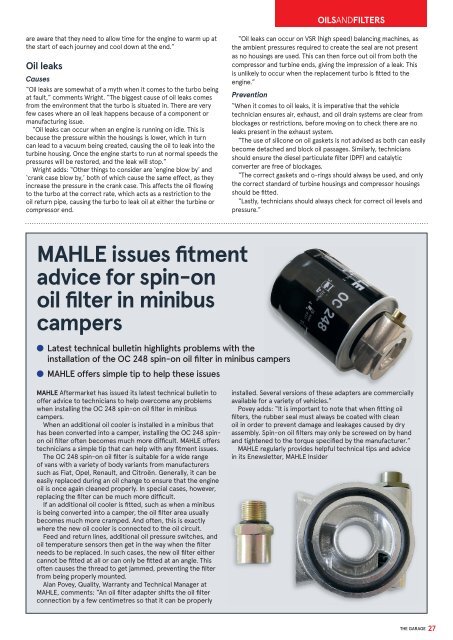The Garage 354
You also want an ePaper? Increase the reach of your titles
YUMPU automatically turns print PDFs into web optimized ePapers that Google loves.
OILSANDFILTERS<br />
are aware that they need to allow time for the engine to warm up at<br />
the start of each journey and cool down at the end.”<br />
Oil leaks<br />
Causes<br />
“Oil leaks are somewhat of a myth when it comes to the turbo being<br />
at fault,” comments Wright. “<strong>The</strong> biggest cause of oil leaks comes<br />
from the environment that the turbo is situated in. <strong>The</strong>re are very<br />
few cases where an oil leak happens because of a component or<br />
manufacturing issue.<br />
“Oil leaks can occur when an engine is running on idle. This is<br />
because the pressure within the housings is lower, which in turn<br />
can lead to a vacuum being created, causing the oil to leak into the<br />
turbine housing. Once the engine starts to run at normal speeds the<br />
pressures will be restored, and the leak will stop.”<br />
Wright adds: “Other things to consider are ‘engine blow by’ and<br />
‘crank case blow by,’ both of which cause the same effect, as they<br />
increase the pressure in the crank case. This affects the oil flowing<br />
to the turbo at the correct rate, which acts as a restriction to the<br />
oil return pipe, causing the turbo to leak oil at either the turbine or<br />
compressor end.<br />
“Oil leaks can occur on VSR (high speed) balancing machines, as<br />
the ambient pressures required to create the seal are not present<br />
as no housings are used. This can then force out oil from both the<br />
compressor and turbine ends, giving the impression of a leak. This<br />
is unlikely to occur when the replacement turbo is fitted to the<br />
engine.”<br />
Prevention<br />
“When it comes to oil leaks, it is imperative that the vehicle<br />
technician ensures air, exhaust, and oil drain systems are clear from<br />
blockages or restrictions, before moving on to check there are no<br />
leaks present in the exhaust system.<br />
“<strong>The</strong> use of silicone on oil gaskets is not advised as both can easily<br />
become detached and block oil passages. Similarly, technicians<br />
should ensure the diesel particulate filter (DPF) and catalytic<br />
converter are free of blockages.<br />
“<strong>The</strong> correct gaskets and o-rings should always be used, and only<br />
the correct standard of turbine housings and compressor housings<br />
should be fitted.<br />
“Lastly, technicians should always check for correct oil levels and<br />
pressure.”<br />
MAHLE issues fitment<br />
advice for spin-on<br />
oil filter in minibus<br />
campers<br />
● Latest technical bulletin highlights problems with the<br />
installation of the OC 248 spin-on oil filter in minibus campers<br />
● MAHLE offers simple tip to help these issues<br />
MAHLE Aftermarket has issued its latest technical bulletin to<br />
offer advice to technicians to help overcome any problems<br />
when installing the OC 248 spin-on oil filter in minibus<br />
campers.<br />
When an additional oil cooler is installed in a minibus that<br />
has been converted into a camper, installing the OC 248 spinon<br />
oil filter often becomes much more difficult. MAHLE offers<br />
technicians a simple tip that can help with any fitment issues.<br />
<strong>The</strong> OC 248 spin-on oil filter is suitable for a wide range<br />
of vans with a variety of body variants from manufacturers<br />
such as Fiat, Opel, Renault, and Citroën. Generally, it can be<br />
easily replaced during an oil change to ensure that the engine<br />
oil is once again cleaned properly. In special cases, however,<br />
replacing the filter can be much more difficult.<br />
If an additional oil cooler is fitted, such as when a minibus<br />
is being converted into a camper, the oil filter area usually<br />
becomes much more cramped. And often, this is exactly<br />
where the new oil cooler is connected to the oil circuit.<br />
Feed and return lines, additional oil pressure switches, and<br />
oil temperature sensors then get in the way when the filter<br />
needs to be replaced. In such cases, the new oil filter either<br />
cannot be fitted at all or can only be fitted at an angle. This<br />
often causes the thread to get jammed, preventing the filter<br />
from being properly mounted.<br />
Alan Povey, Quality, Warranty and Technical Manager at<br />
MAHLE, comments: “An oil filter adapter shifts the oil filter<br />
connection by a few centimetres so that it can be properly<br />
installed. Several versions of these adapters are commercially<br />
available for a variety of vehicles.”<br />
Povey adds: “It is important to note that when fitting oil<br />
filters, the rubber seal must always be coated with clean<br />
oil in order to prevent damage and leakages caused by dry<br />
assembly. Spin-on oil filters may only be screwed on by hand<br />
and tightened to the torque specified by the manufacturer.”<br />
MAHLE regularly provides helpful technical tips and advice<br />
in its Enewsletter, MAHLE Insider<br />
THE GARAGE 27<br />
28<br />
22-27 Feature Oils and filters.indd 6 30/08/2023 15:18

















